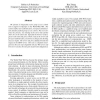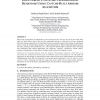187 search results - page 2 / 38 » Discovering user access patterns on the World Wide Web |
WETICE
1998
IEEE
13 years 9 months ago
1998
IEEE
We present an integrated secure group access control tool to support workgroups on the World-Wide Web. The system enables user authentication, encrypted communication and fine-gra...
EUSFLAT
2007
13 years 7 months ago
2007
Finding sequential patterns is one of important issues in data mining. This paper deals with linguistic (fuzzy) sequential patterns. The existing algorithms for discovering such p...
WISE
2005
Springer
13 years 11 months ago
2005
Springer
Web transaction data between Web visitors and Web functionalities usually convey user task-oriented behavior pattern. Mining such type of clickstream data will lead to capture usag...
CORR
2010
Springer
13 years 5 months ago
2010
Springer
Most of the organizations put information on the web because they want it to be seen by the world. Their goal is to have visitors come to the site, feel comfortable and stay a whi...
WWW
2005
ACM
14 years 6 months ago
2005
ACM
We describe Thresher, a system that lets non-technical users teach their browsers how to extract semantic web content from HTML documents on the World Wide Web. Users specify exam...


